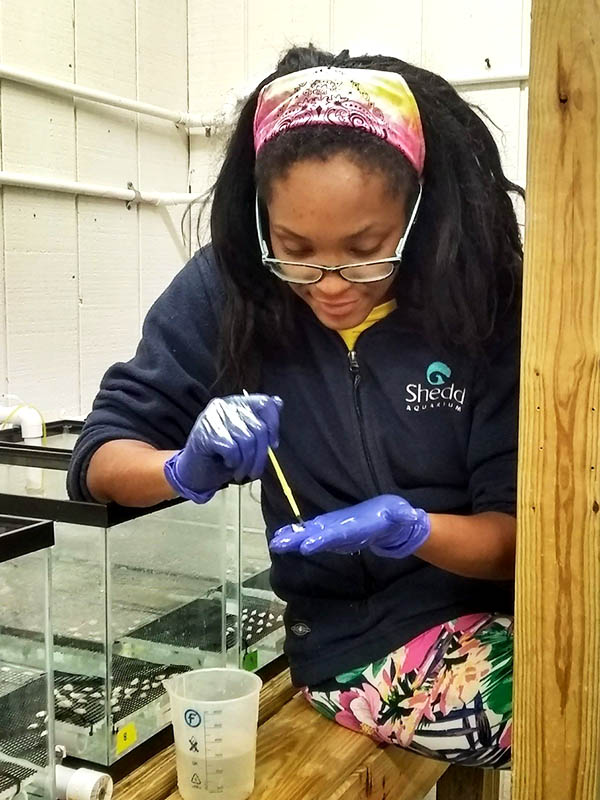Oyster Contaminants
Full Title: Use of elemental signatures to detect and trace contaminant entry to the northern Gulf of Mexico coastal food web: Managing multiple stressors
This project tested whether trace elements associated with oil can be detected in oyster shells and serve as an indicator of oil exposure thus providing resource managers with a way to detect past oil exposure on oyster reefs.

The Team: Ruth Carmichael (Lead Investigator, Dauphin Island Sea Lab, University of South Alabama, rcarmichael@disl.org)
Technical Monitor: Dennis Apeti (dennis.apeti@noaa.gov)
Federal Program Officer/Point of Contact: Frank Parker (frank.parker@noaa.gov)
This project began in June 2017 and ended in May 2021.
Award Amount: $231,671
Why it matters: Oysters can serve as a record of water conditions at a particular site because they are stationary filter feeders with a hard shell that incorporates elements from the surrounding water as it continually grows. By determining if trace elements associated with oil exposure are incorporated into a living oyster’s shell and under what conditions, the investigator will provide resource managers with an approach to detect when an oyster is exposed even after the oil is no longer present.
What the team did: This study tested whether current or past exposure to contaminants may have affected the status of restored oyster reefs in Alabama, Mississippi, and Louisiana. These experiments worked to determine if the chemical fingerprint in oyster shell can be linked back to exposure of that oyster to a contaminant. Because oysters live in waters that vary in salinity, particularly on the Northern Gulf of Mexico coast, where freshwater discharge can be very high, this link was tested under different salinities. Understanding this linkage helps to make it possible to use historical oyster shell and tissue samples to assess past contaminant exposure at different sites. The trace element profiles in the shell of oysters exposed to contaminants were compared to measures of the biological condition of the oyster, such as growth rate, to relate the condition of oysters at a particular site following contaminant exposure. Using data on mortality and abundance at active oyster restoration sites, this project worked to assess whether current or previous exposure to contaminants may be related to the status of a restored reef, where historical data are available.
Summary of Outcome: The team used quadrupole laser ablation and solution-based Inductively coupled plasma mass spectrometry (ICP-MS) for trace metal analyses and isotope ratio mass spectrometry (IRMS) for stable isotope analyses in shell and soft tissues of native and lab-reared oysters. Native oysters were obtained from restored reef sites in LA, MS, and AL, with different expected pollution from nearby anthropogenic sources, and lab-reared oysters were exposed to different types of contaminated water at two salinities (14, 25) to test this common local environmental stressor. They found that oysters assimilated elements into their shells from their environment, but the ratios of elements assimilated did not reflect an oil-specific trace metal profile. Salinity and oil concentration affected oyster growth and assimilation of trace metals into oyster shells. Stable isotope ratios in field and lab-reared oysters reflected ambient particulate diet. Trace metal profiles in oysters from native reefs varied seasonally and among locations relative to estimated anthropogenic land-use, traceable in time using δ18O variation with shell height. Trace metal concentrations in shell increased predictably with concentrations in tissue, with higher variation at lower salinity. The number and composition of detectable n-alkanes, indicative of petrochemicals, suggest that oysters in LA and AL likely assimilated the highest magnitude and proportion of petrogenic C, respectively. This study was aligned to previous field transplant studies to provide insight into application of a new technique, using bivalve shells as retrospective indicators of water pollution.
Overall, shell can be a direct proxy for tissue for some elements and at least predictive for others, showing variation with local hydrology, adjacent land use, and season. This approach has potential to enhance future biomonitoring, restoration, and management efforts, including those by NOAA’s Mussel Watch Program that currently rely on soft tissue (shorter-term) analyses. Applications of this approach will likely be most successful where environmental conditions that simultaneously affect contaminant bioavailability and oyster physiology (e.g., salinity) are well defined.
From the seminar “Eastern Oysters (Crassostrea Virginica) as Retrospective Bioindicators of Trace Metal Contamination”
Presenter: Dr. Ruth Carmichael, Dauphin Island Sea Lab, University of South Alabama
Other Resources
N/A
N/A
 Official websites use.gov
A .gov website belongs to an official government organization in the United States.
Official websites use.gov
A .gov website belongs to an official government organization in the United States.
 Secure .gov websites use HTTPS
A lock or https:// means you’ve safely connected to the .gov website. Share sensitive information only on official, secure websites.
Secure .gov websites use HTTPS
A lock or https:// means you’ve safely connected to the .gov website. Share sensitive information only on official, secure websites.